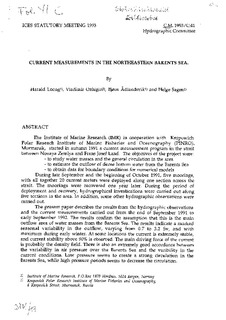| dc.description.abstract | The Institute of Marine Research (IMR) in cooperation with Knipowich
Polar Reseach Institute of Marine Fisheries and Oceanography (PINRO),
Murmansk, started in autumn 1991 a current measurement program in the strait
between Novaya Zemlya and Frans Josef Land. The objectives of the project were:
- to study water masses and the general circulation in the area
- to estimate the outflow of dense bottom water from the Barents Sea
- to obtain data for boundary conditions for numerical models.
During late September and the beginning of October 1991, five moorings,
with all together 20 current meters were deployed along one section across the
strait. The moorings were recovered one year later. During the period of
deployment and recovery, hydrographical investications were carried out along
five sections in the area. In addition, some other hydrographic observations were
carried out.
The present paper describes the results from the hydrographic observations
and the current measurements carried out from the end of September 1991 to
early September 1992. The results confirm the assumption that this is the main
outflow area of water masses from the Barents Sea. The results indicate a marked
seasonal variability in the outflow, varying from 0.7 to 3.2 Sv, and with
maximum during early winter. At some locations the current is extremely stable,
and current stability above 90% is observed. The main driving force of the current
is probably the density field. There is also an extremely good accordance between
the variability in air pressure over the Barents Sea and the varibility in the
current conditions. Low pressure seems to create a strong circulation in the
Barents Sea, while high pressure periods seems to decrease the circulation. | no_NO |
